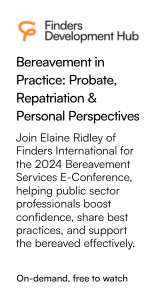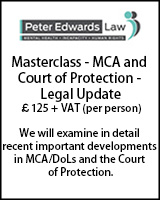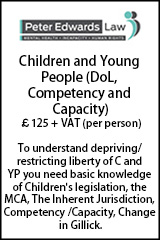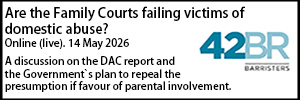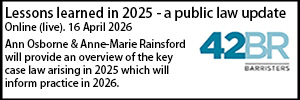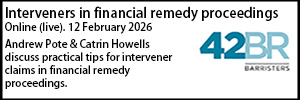Children law update - December 2024
- Details
Michael Jones KC rounds up the latest children law cases of interest to practitioners.
It is never a good thing when your client lies on oath but, as the authorities make clear, Judges have to be cautious about inferring a party is culpable for injury or abuse, just because they tell a lot of lies. Lucas is alive and well. Re H (Children: Uncertain Perpetrator: Lies) [2024] EWCA Civ 1261 is a Court of Appeal decision with the lead judgment being given by Peter Jackson LJ; the salient facts of the case were that one of the subject children had suffered bruising and fractures on at least two occasions, with the Judge at first instance finding that these constituted inflicted injuries with the perpetrator being either the mother or the intervenor, both of whom had told a number of lies during the investigations. In particular the mother admitted lying to a health visitor on the day before the child’s admission to hospital, by asking her not to visit because the family had a sickness bug. The mother explained this lie as being because she was concerned about what the health visitor would think about the bruising and because she had not done some paperwork. The judge found that it was a deliberate lie to deceive the health visitor because the mother did not want there to be any investigation into the bruising. The mother also lied about the continuation of her relationship with the intervenor, which the Judge found to be a significant lie and deception. The Judge was satisfied that the intervenor knew that the mother was misleading professionals and also lied about his cocaine use. The Judge was unable to identify a perpetrator.
In her judgment, the Judge cited directly cited from the Court of Appeal’s decisions in Re H-C (Children) [2016] EWCA Civ136, and Re A, B and C (Children) [2021] EWCA Civ 451. The passage from H-C reads:
"99. In the Family Court, in an appropriate case, a judge will not infrequently directly refer to the authority of Lucas in giving a judicial self-direction as to the approach to be taken to an apparent lie. Where the "lie" has a prominent or central relevance to the case, such a self-direction is plainly sensible and good practice.
100. In my view, there should be no distinction between the approach taken by the criminal court on the issue of lies to that adopted in the family court. Judges should therefore take care to ensure that they do not rely upon a conclusion that an individual has lied on a material issue as direct proof of guilt."
The passage from Re A, B and C reads:
"58. … In these circumstances, I venture to suggest that it would be good practice when the tribunal is invited to proceed on the basis, or itself determines, that such a direction is called for, to seek counsel's submissions to identify: (i) the deliberate lie(s) upon which they seek to rely; (ii) the significant issue to which it/they relate(s), and (iii) on what basis it can be determined that the only explanation for the lie(s) is guilt. The principles of the direction will remain the same, but they must be tailored to the facts and circumstances of the witness before the court."
The argument on appeal was that the judge failed to identify the relevance of the mother’s lies to the issue of perpetration or explain how those lies led to her ultimate finding. Peter Jackson LJ rejected this as a basis for the appeal;
‘I do not accept that the judge approached this issue incorrectly or that her analysis was inadequate. She was obliged to exercise an overview of the totality of the evidence: Re T [2004] EWCA Civ 558 at [33] and to survey a wide canvas, including a detailed history of the parties' lives, their relationship and their interaction with professionals: Re U, Re B [2004] EWCA Viv 567 at [26]. In that context, she understandably found the lies to the health visitor and to the court to be significant. Their relevance was clear. One lie involved shielding a child with bruising from a professional at an important point in the chronology and another took the form of sustained collusion between the two adults who had had day-to-day care. The judge did not deploy them in order to make a positive finding, but in part-explanation of why she found herself unable to identify a single perpetrator. Beyond identifying their relevance and significance, and considering the explanations offered by the mother, she was not required to do more.
Lies, where they are admitted or alleged, will form just one part of the overall evidence in family proceedings. The underlying purpose of the Lucas direction is to ensure that proven lies are assessed with a sense of proportion. In relation to welfare, it has been said that they should not be allowed to hijack the case (Re Y [2013] EWCA civ 1337 per Macur LJ at [7(4)]) and, as I put it in Re K (Children: Placement Orders) [2020] EWCA (Civ) 1503 at [29], that the link between lies and welfare must be spelled out.
The same discipline applies to fact-finding. The court's view of a witness's overall credibility and reliability will naturally contribute to its evaluation of whether it can accept their evidence on the critical issues. If it concludes that lies have been told, it will consider what weight, if any, should be given to that aspect of the matter, after due consideration of any explanations that have been offered. That is part of the normal process of sifting and weighing the evidence, and explaining the result. The family courts encounter many forms of bad behaviour and they are used to assessing their true significance for the issue in hand. There is no special rule of evidence for lies.
I would therefore make one observation about the description of good practice in Re A, B and C. At [58(iii)] it is said that the court should seek to identify the basis on which it can be determined that the only explanation for the lie(s) is guilt. That draws on the slightly different jury direction in the Crown Court Compendium at 16-3, which requires that a lie is only capable of supporting other evidence against a defendant if the jury are sure that it was not told for a reason advanced by or on behalf of the defendant, or for some other reason arising from the evidence, which does not point to the defendant's guilt.’
Peter Jackson LJ rejected the submission that the Family Court is required to exclude a lie from consideration altogether in any case where it cannot be satisfied (to whatever standard) that the only explanation for it is to conceal guilt. His Lordship reiterated that the Judge was entitled to take account of the lies told by both adults in her overall survey of the evidence. A Judge is not required to ignore lies unless the only explanation for them was guilt. In this case, one highly significant deception (the false separation) was maintained, for whatever motive, by both possible perpetrators and Peter Jackson LJ commented upon the artificiality of a Court having to ignore a lie unless it unmistakeably demonstrated guilty knowledge on the part of the one who had caused the injuries. In summary, lies are relevant when exercising a judicial overview of the totality of the evidence in the case; in some cases they may be significant, in others less so.
Re M (Children: Contact In Prison) [2024] EWCA Civ 1104 is for me, an interesting decision from the Court of Appeal, as it confirms that PD 12J remains just as important as ever, despite the current emphasis on limiting the duration of proceedings and ensuring that fact finding exercises are not embarked upon unless absolutely necessary. In this case Lieven J at first instance, made a decision directing that the two subject children were taken to prison for direct contact with their father, who was serving a sentence for multiple rapes perpetrated upon the mother. The Guardian recommended written contact only and did not consider it appropriate for the mother to be ordered to take the children to see someone who was guilty of significant offences against her. She considered the children's views (they both wished to have contact with their father) to be of the utmost importance, but the impact on the mother as the victim and primary carer could not be ignored. Similarly, the Guardian did not support contact with either the father or his partner being unsupervised as (based on previous instances of Court orders being disregarded) she was not convinced that they could be trusted in what they would tell the children about the offences or about their mother. Even twice-weekly telephone contact would impact on the children’s ability to get on with their daily lives and would in the Guardian’s view leave the mother with a sense of continued control by her ex-partner.
The Judge’s order required the mother to make the children available to spend time with the father (1) for a one-off visit in prison facilitated and supported by the Guardian and her solicitor for up to 2 hours, (2) for visits to prison three times a year for four hours, accompanied by the father’s partner, with the children being handed over to her at a public car park for that purpose, and (3) for telephone contact once a month for 30 minutes. The judge also made a section 91(14) order for a year, but gave the Guardian liberty to apply in relation to subsequent visits if the one-off visit proved (in the Judge’s word) disastrous.
Once again, Peter Jackson LJ gives judgment; it is as ever, succinct, targeted and eloquent. Importantly, Peter Jackson LJ focussed on both the relevant elements of the welfare checklist and PD 12J;
‘In this case, the checklist is supplemented by PD12J. Paragraph 36 requires the court to apply the individual matters in the welfare checklist with reference to the domestic abuse which has occurred and any expert risk assessment obtained. Specifically, the court should consider any harm the parent with care has suffered as a consequence of the domestic abuse, and which the child and the parent are at risk of suffering, if an order is made. The court should only make an order for contact if it is satisfied that the physical and emotional safety of the child and the parent with whom the child is living can, as far as possible, be secured before, during and after contact, and that the parent with whom the child is living will not be subjected to further domestic abuse by the other parent. Paragraph 37 requires the court to consider the conduct of both parents towards each other and the impact of it. In particular the court is to consider:
"(d) the likely behaviour during contact of the parent against whom findings are made and its effect on the child; and
(e) the capacity of the parents to appreciate the effect of past domestic abuse and the potential for future domestic abuse."
The Judge was right to consider this a difficult case. The issue of the father's contact required careful consideration and, almost certainly, the resolution of disputed issues, such as what effect the father's behaviour has had on the mother, what impact an order for contact would have on her ability to parent the children in the way they now need, and whether meetings with the father and Ms V would by one means or another expose the children to a damaging conflict of loyalties.’
The appeal was allowed on the basis that Lieven J failed to take into account of adequately evaluate the following factors;
(1) The fact that the father hasd been convicted of domestic abuse of a most harmful kind, a finding which binds the Family Court.
(2) The impact of the rapes and of the order on the mother, as required by PD12J.
(3) The significance of the father's unrepentant attitude since conviction as a measure of his ability, and that of his partner, to meet the children's needs.
(4) The weight that was properly due to the children's wishes in the light of their limited understanding of the family situation and their apparently settled state.
(5) The balance between their need for contact with their father and their need for continuity of secure care by their mother.
(6) The potential for unsupervised contact to unsettle the children and harm their relationship with their mother by exposing them to conflicting narratives.
(7) The appropriateness of the father’s partner being the facilitator of contact, given her identity of views with the father.
(8) The practicality of telephone contact being supervised.
(9) The justification within the evidence for rejecting the expert assessment of the Guardian.
I found this judgment reassuring as it makes clear that no matter what the individual child’s wishes and feelings are in relation to contact, decisions must be made having regard to all relevant elements of the welfare checklist and in cases where appropriate, PD 12J. PD 12J still plays a hugely important role within private law proceedings and simply cannot be ignored.
Next up, Re Y, V & B (Fact-Finding: Perpetrator) [2024] EWCA Civ 1034 acts as a timely reminder of the relevant principles applicable to identification of a perpetrator and, if this is not possible, the making of a ‘pool’ finding. This case concerned a child who suffered a number of serious injuries, the medical evidence relating to which was uncontested. The fact-finding hearing took place over five days in March 2024. It was the local authority’s case that the injuries were inflicted deliberately or through negligent handling and that the mother was the perpetrator. The mother’s response recorded in the threshold document was that she had never harmed her child, that she did not know how the injuries were caused, and that there was a real possibility that they could have been caused accidentally when the mother was not present. It was the mother's case, however, that she was not aware of the child sustaining her injuries during any of those periods.
Matters appeared to go astray when the Judge, prior to reading her judgment, announced her decision. The Court of Appeal inferred from the transcript of the exchanges between the Judge and counsel following judgment that she may have taken this course at the request of the mother’s counsel. Counsel’s note was that the Judge said words to this effect:
"if the mother did not cause them [the injuries], she should have known who did".
This was, however, not included in the transcript of the judgment subsequently prepared and approved by the Judge. The Judge found that the mother had lied about when she noticed swelling to the child’s head, but that this lie was a result of shame due to a failure to seek medical attention as opposed to being evidence of guilt. The Judge found that the injuries were inflicted deliberately or through reckless use of force. She then considered the issue of perpetrator in the following two paragraphs.
"As to the identity of the perpetrator, I am unable to make a positive finding that the mother herself caused the injuries. Partly that is because I have taken into account all of the surrounding evidence that shows the mother as a gentle and loving parent. I find myself in this position also because I am quite clear that the court has not been given a full and complete account in this case of what happened in B's life over the relevant period.
I do make a finding that the mother knows how the injuries were caused and has chosen not to tell the truth. That finding, in my view, is inescapable. To make that finding is not to reverse the burden of proof but to acknowledge that the weight of the evidence leads to a conclusion that it is not realistically possible that these injuries could have been sustained without the mother being aware. The threshold criteria are met on that basis."
There was then an exchange between counsel and the Judge relating to her findings. The central ground of appeal was that having correctly concluded that the injuries were inflicted, the Judge was wrong to refuse to identify a perpetrator or a "pool" of perpetrators. Alternatively, if the Judge had identified a pool of perpetrators, then it is a pool of the mother and a hypothetical other person and that was neither borne out on the factual evidence or allowed in law.
The appeal was allowed, with Baker J concluding that the failure to make any finding identifying a perpetrator and her belief that the case could safely continue on the basis of her findings set out above, was wrong in law;
‘Although it is not invariably necessary for the perpetrator, or pool of possible perpetrators, of non-accidental injuries to a child to be identified for the attributability condition in s.31(2) to be satisfied, it is in most cases important for the court to do so if it can for the reasons set out by Baroness Hale in Re S-B. All of the reasons for identifying the perpetrator or the pool of possible perpetrators identified by Baroness Hale in Re S-B arise in this case. "It will help to identify the real risks to the child[ren] and the steps needed to protect him. It will help the professionals in working with the family. And it will be of value to the child[ren] in the long run."
The judge was wrong to conclude the fact-finding stage in this case, in which a young child has sustained serious non-accidental injuries on more than one occasion, without either finding on a balance of probabilities that a named person was the perpetrator or finding that persons (named or unnamed) were in the pool of perpetrators. It is impossible to ignore her repeated statements during the post-judgment exchanges with counsel, culminating in the clear statement after consulting her notes that her finding was "certainly meant to include the possibility of the mother as perpetrator". There is nothing in the approved transcript of the judgment, or in her later emails, to indicate why the judge declined to make that finding which during exchanges with counsel she had indicated she had certainly meant to make.
This was precisely the sort of situation where a judge should follow the disciplined approach prescribed by Peter Jackson LJ in Re B – identify a list of possible perpetrators (including named and, where appropriate, unnamed persons); consider whether the local authority has proved on a balance of probabilities that a person was the perpetrator; if not, identify those persons on the list in respect of whom there was a real possibility that they were the perpetrator. If she had taken that course, it is unlikely that the judge would have gone astray.’
The Judge should either have identified a perpetrator or have alternatively gone on to consider the alternative finding that the identity of the perpetrator could not be established on a balance of probabilities but there was a real possibility that the mother or another person was the perpetrator. This was never canvassed during the evidence or in submissions as the local authority asserted the perpetrator was the mother, however Baker J reminds us that;
‘a Judge "is not required slavishly to adhere to a schedule of proposed findings placed before her by a local authority" but may, if there are good reasons, make findings of fact which are not sought by the local authority, provided "(a) that any additional or different findings made are securely founded in the evidence; and (b) that the fairness of the fact finding process is not compromised…..
…. the obligation to ensure the "fairness of the fact-finding process" is owed to all parties, including the local authority and the children. If the court in assessing the evidence forms a view that the evidence may support findings on a basis which has not been raised or considered during the hearing, it is incumbent on the court to address that possibility if the potential findings are material to the welfare decisions which it is required to make about the children. That may lead to an extension or even an adjournment of the hearing. But where the findings, if made, would have a material impact on decisions about the child's long-term care, the court cannot avoid considering them, whatever the inconvenience that may cause.’
This judgment reminds us (1) of the need to adhere carefully to the relevant authorities relating to identification of a perpetrator and, where this is not possible, to consideration of a ‘pool’ finding, and (2) the fact that the Court is not bound by or limited to specific findings sought by a local authority, albeit proceedings must be dealt with fairly and the opportunity for parties to address the potential of findings of fact which are not sought by the local authority, being made, must be provided by the Court.
The next COA decision I am going to refer to is D-S (A Child: Adoption or Fostering) [2024] EWCA Civ 948 (the third Peter Jackson LJ judgment in this update!). The question on this appeal was whether a Judge was wrong to refuse to make an order allowing an 11-month-old child to be placed for adoption. The Court of Appeal allowed the appeal and set aside the Judge’s decision for a number of reasons, namely the fact that he did not take the correct legal approach.
‘He was wrong to say that the professional assessments had fallen short. He needed to make an all-round assessment of the child’s welfare, but he gave little or no weight to matters that were clearly important and he was influenced by matters that were not. His explanation of why he reached his decision is hard to follow.’
Peter Jackson LJ set out the relevant line of authorities relating to long-term fostering v adoption, which are thorough and merit reading in full. His Lordship then went on to make the following observations in relation to the issue regarding the availability of adoptive placements;
‘I start with the judge's remark about the lack of evidence about the availability of placements. It may have been directed to the availability of foster placements, but he was clearly equally concerned about the availability of adoptive placements. However, no party had argued that further evidence was necessary in either respect. The application for a placement order had been on foot for several months and there had been an Issues Resolution Hearing in February. The perception that there was a gap in the evidence was felt by the judge alone. In my view, it was a misperception. When faced with a choice between adoption and fostering, the court's primary task is to take a decision as to whether one or the other is right for the child as a matter of principle. In order to do that, it will not usually have to have evidence about the availability of placements: Re T (Placement Order) (CA) [2008] 1 FLR at [17]. There may be cases at the margins where specific evidence will be necessary, examples being where the plan is for the adoption of a much older child, or the placement of a child with severe health or behavioural problems, or of a large sibling group. In this case, there were no special features of that kind and no inadequacy in the local authority's evidence. Specifically, it did not need to show what foster home or homes could be found for the three children. That search had to be made after the court had taken its decision in principle. Further, if there had been a gap in the evidence, the judge should have adjourned and given directions for it to be remedied. It was not open to him to go ahead regardless. He considered adjourning at paragraph 43, but did not explain why he was not doing that. His suggestion that the local authority might apply for a placement order at a later date was, as he recognised, undesirable. I would go further, and say that it was probably wrong in principle, bearing in mind the statutory presumption in relation to delay.’
I found these comments useful given my experience of requests by parties for evidence relating to the availability of prospective adoptive placements in care proceedings or where the Court considers this specific issue.
Ultimately the Judge’ reasoning was flawed, placed too greater emphasis on the advantages of maintaining family ties and failed to properly consider the manifest disadvantages with a life in foster care. The Court of Appeal in allowing the appeal, went on to make its own welfare evaluation and granted a placement order to the local authority. Cases involving long-term foster care vs adoption are often very tricky as there are so many pros and cons associated with both alternative care plan, albeit in relation to very young children, there is the very obvious advantage that an adoptive placement brings in relation to a stable family life (albeit my depressing recent experiences of adoption breakdowns act as a constant reminder to me of the devastating impact of adoptions ‘going wrong’ for children and families).
My final case of note for this update is R & C (Adoption or Fostering) [2024] EWCA Civ 1302. This is a timely and in my view important judgment; it is an appeal against a Judge’s refusal to make placement orders in relation to two young children, with the principal reason for that decision being that adoption was inconsistent with the children’s need for continuing contact with members of their birth family, in particular their two elder half-siblings. The judgment of Baker LJ provides a comprehensive summary of the law in relation to post-adoption contact and the appeal was allowed due to various flaws in the Judge’s analysis. Importantly, the local authority had invited the Judge to make an order under s.26 relating to sibling contact and the Court of Appeal in allowing the appeal, undertook its own welfare analysis and granted placement orders in addition to an order under s.26 of the 2002 Act;
‘I would therefore propose that this Court allows the local authority's appeal, sets aside the judge's order, and makes placement orders in respect of both children. In addition, pursuant to s.26(2)(b) of the 2002 Act, I would add an order requiring the person(s) with whom R and C live, and any other person(s) with whom they are to live while they remain the subjects of placement orders, to allow them to attend visiting contact with their siblings N and Y six times per year, in accordance with arrangements made by the local authority. I would include in the order a recital, in terms proposed by the local authority, recording that"the local authority confirming that, under its care plans and during its search for prospective adopters for R and C
(1) that the local authority will arrange direct inter-sibling contact between the subject children and their siblings N and Y, six times per year;
(2) that the local authority will search exclusively for and will match the subject children only with prospective adopters committed to facilitating inter-sibling contact as set out above and who will propose to adopt both the subject children;
(3) that, in the event that prospective adopters committed to facilitating inter-sibling contact as set out above have not been found within six months, the local authority will apply to the court.’
This really stresses the need to fully and properly consider contact and the necessity for any order pursuant to s.26, when considering an application for a placement order.
Michael Jones KC is a barrister at Deans Court Chambers.
























